Concrete Lifting & Slab Stabilization for Residential, Commercial, and Municipal Properties in Florida
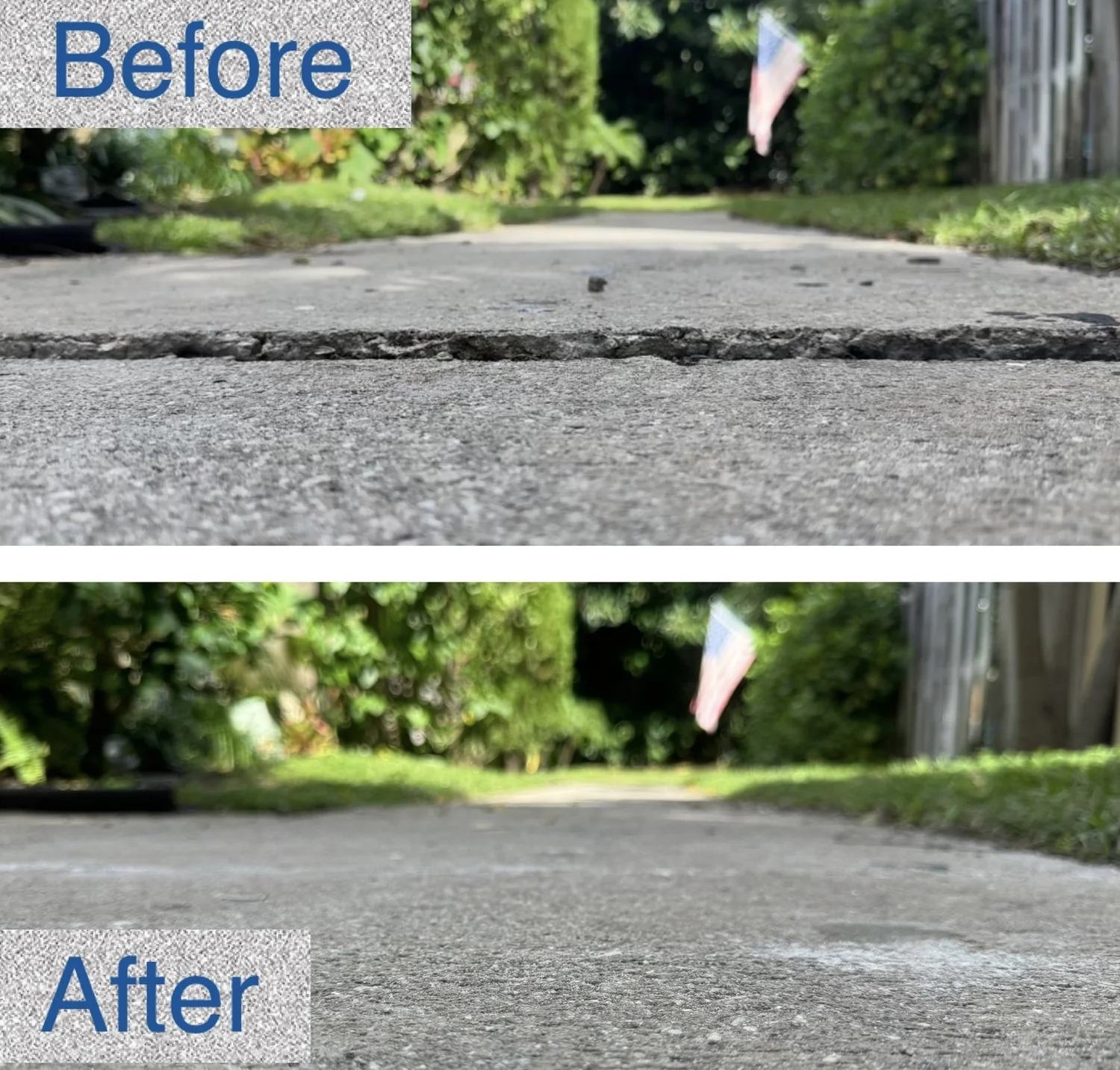
Polyurethane foam injection in action — fast, clean, long-lasting concrete lifting and stabilization for Florida properties.
Concrete Lifting and Stabilization Across Florida
Concrete is everywhere in Florida — driveways, pool decks, patios, school sidewalks, playground pads, warehouse floors, golf cart paths, and municipal walkways. When slabs settle or lose support, the result isn’t just cosmetic. Uneven concrete creates trip hazards, traps water against structures, accelerates cracking, and can interrupt business operations. The good news: you don’t have to replace the concrete to fix it. At Floridian Concrete Lifting, we lift and stabilize failing slabs with polyurethane concrete lifting — a precise, minimally invasive process that fills voids, re‑supports the slab, and restores function the same day.
Below, we cover why slabs sink in Florida, how our process works step‑by‑step, where it makes the biggest impact (homes, HOAs, schools, warehouses, golf courses, and municipalities), and why polyurethane foam is the most reliable, cost‑effective fix for Florida soils and weather. You’ll also see real examples, maintenance tips, and FAQs to help you choose the best solution for your property.
Why Concrete Slabs Sink and Need Lifting in Florida
Florida’s environment is tough on concrete. Sandy soils don’t lock together like clay; heavy rains arrive fast; and many properties sit over a high water table. Over time, those forces lead to voids — empty spaces under a slab — and once a slab loses support, it settles, tilts, or cracks. The most common drivers we see:
- Gutter runoff & poor downspout placement: Water discharging at slab edges saturates soils and washes fines away, leaving gaps beneath patios, walkways, and driveways.
- Stormwater & erosion: Tropical downpours and irrigation flows scour subgrade soils, especially on slopes or near curbs and edges.
- High water table & moisture swings: Rising and falling groundwater moves soil, weakens bearing capacity, and promotes voids.
- Utility/repair trenches: After plumbing or electrical work, backfill settles for months or years, creating long, narrow voids.
- Poor initial compaction: Fill dirt under driveways, patios, and pool decks wasn’t compacted enough during construction.
- Tree roots & organic decay: Roots can lift slabs and, as they die back, leave voids behind.
- Heavy loads: Forklifts, trailers, delivery trucks, and concentrated equipment stress marginal soils and speed settlement.

Gutter runoff aimed at slabs is a top cause of settlement — extend downspouts to discharge water away from concrete (void filling can restore support after washout).
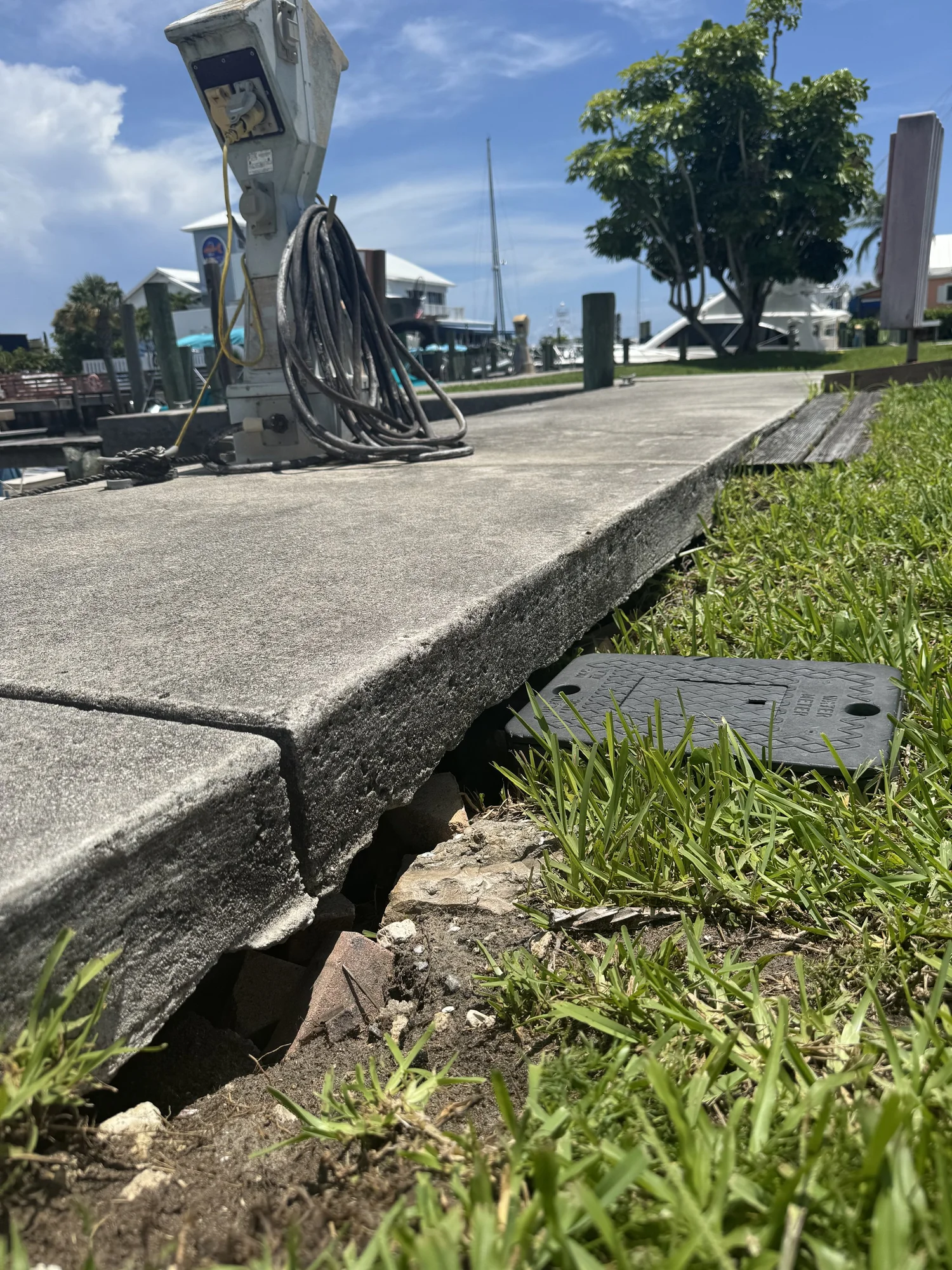
Heavy rain and surface runoff can wash out fine soils beneath cart paths and sidewalks, leaving slabs unsupported — a great fit for concrete lifting.
Early Warning Signs Before Lifting Becomes Urgent
Watch for hairline cracks that widen, edges that sound hollow when tapped, puddles that linger after rain, doors rubbing on interior slab homes, or forklifts that “thump” at warehouse joints. Catching settlement early makes lifting and stabilization faster and more affordable.
How Our Concrete Lifting & Stabilization Process Works
Our method targets voids beneath the slab and re‑establishes uniform support using expanding, high‑density polyurethane foam. We lift where needed and stabilize everywhere the support is compromised. Here’s the step‑by‑step process:
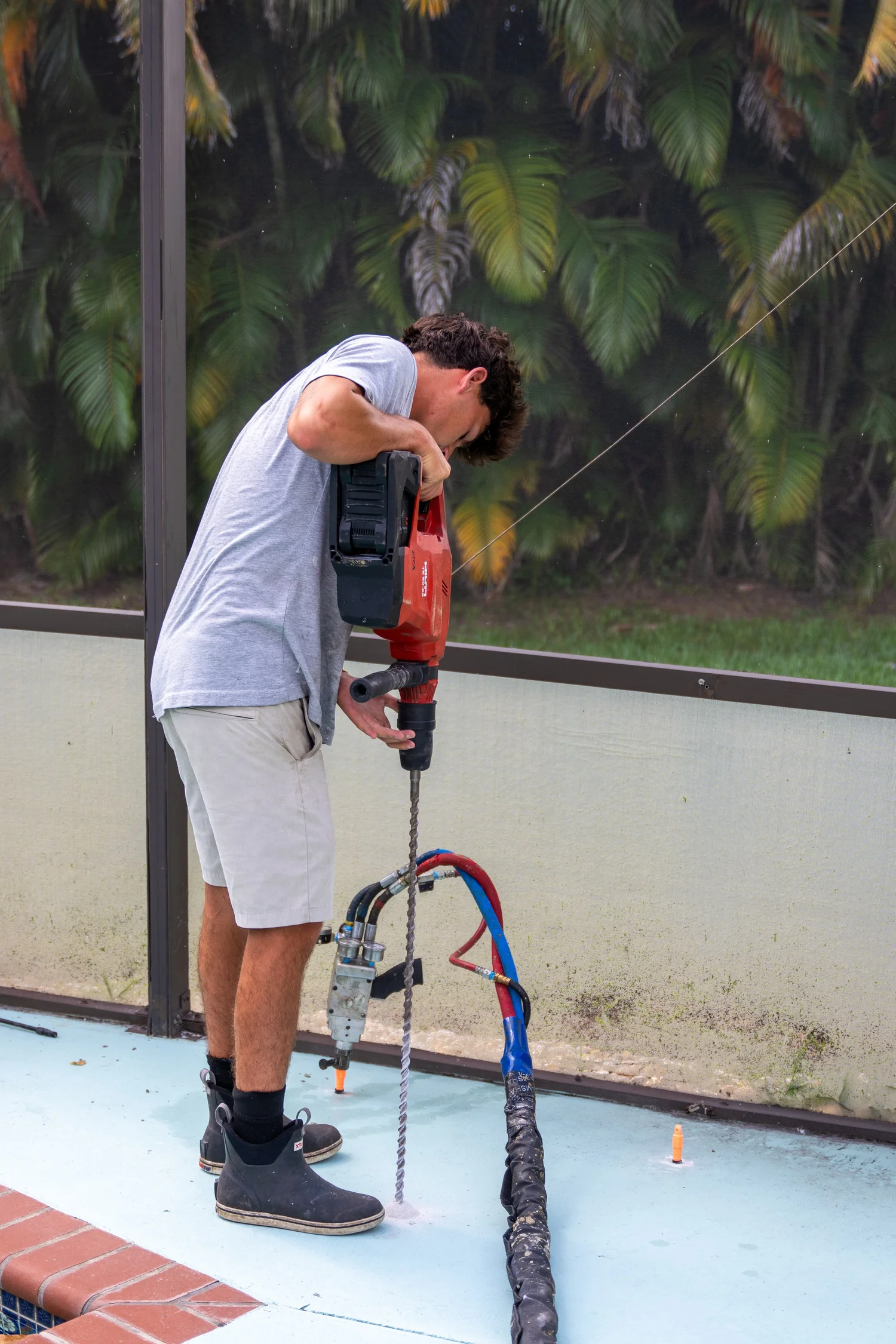
We drill small, strategic injection ports — typically 5/8–3/4" — to reach voids with precision and keep the surface clean.
- Assessment & mapping: We inspect drainage, locate voids, note cracks/elevations, and plan injection points for uniform support and controlled lift.
- Precision drilling: Small, clean holes are laid out so foam flows through weak zones and fills hidden cavities.
- Foam injection: We pump high‑density polyurethane through the ports. The foam expands, displaces water, fills voids, and densifies the surrounding soil matrix.
- Controlled lift & stabilization: As the material expands, we monitor movement in real time. The goal is stable, even support and — where appropriate — gentle lift toward proper elevation.
- Patch & polish: We patch each port with a durable mortar blend. In most cases, areas are ready for foot traffic within minutes and vehicle traffic the same day.
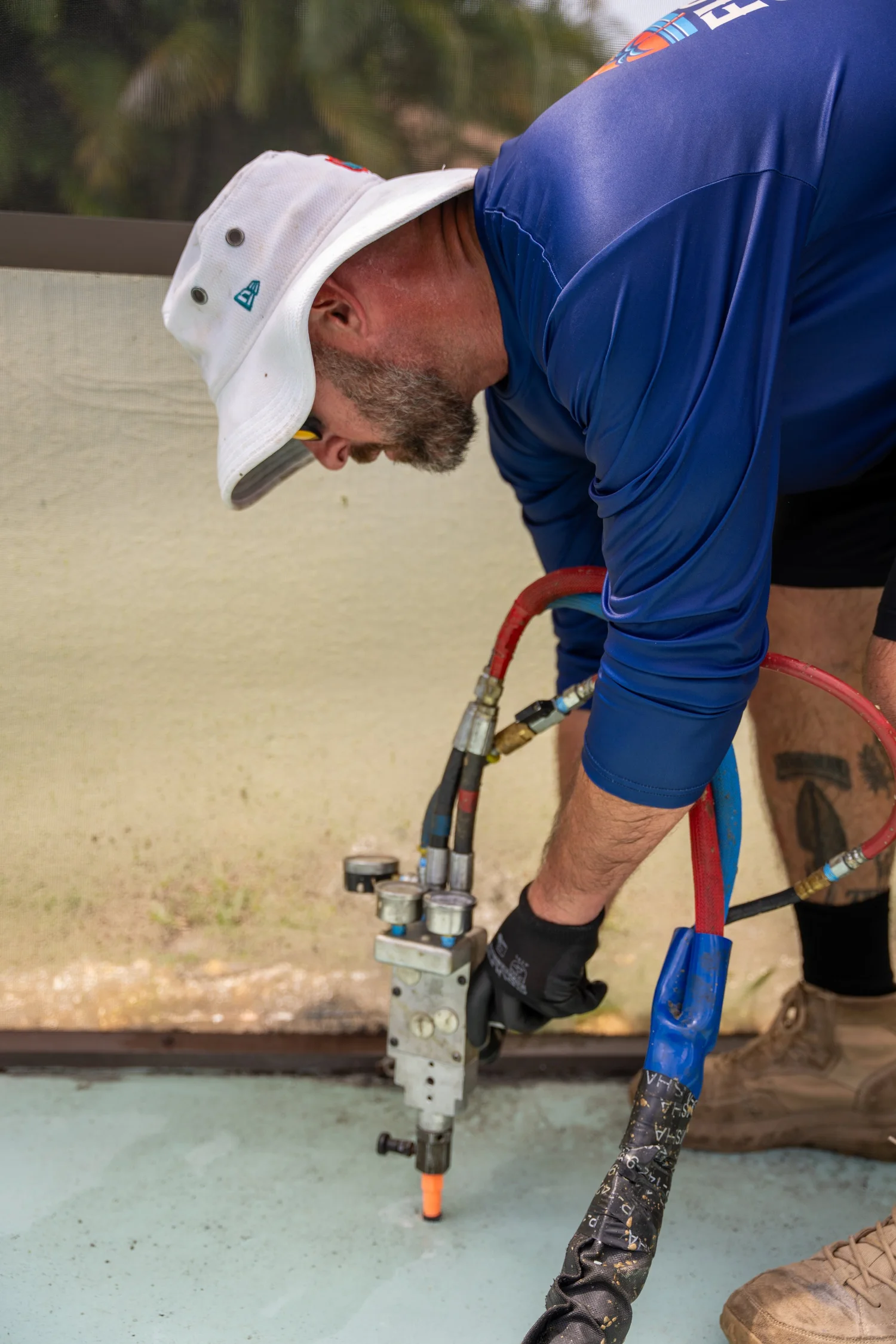
High‑density polyurethane expands underground to fill voids and re‑support concrete — minimal disruption, maximum effect. Learn more on our Concrete Lifting page.
Why Foam Lifting Beats Replacement (and Mudjacking)
- Non‑invasive: Tiny ports vs. demolition and days of curing.
- Fast: Most projects finish in hours; areas are usable the same day.
- Waterproof & lightweight: Foam doesn’t wash out and won’t overload weak subgrade like cement slurries can.
- Durable: Designed to last for decades in Florida’s moisture and heat.
- Cost‑effective: Typically a fraction of tear‑out and replacement — with far less downtime.
See the difference on our Concrete Lifting service page, and read about soil support on Void Filling.
Where Concrete Lifting & Stabilization Makes the Biggest Difference
We work across residential, commercial, educational, and municipal properties. If it’s a concrete slab, there’s a high chance we can lift and stabilize it — indoors or out.
Homes: Driveways, Patios, Pool Decks, & Interior Slabs
Homeowners often first notice dips where driveway slabs meet the garage, edges settling around pool coping, or interior slab rooms that feel “hollow.” Lifting returns surfaces toward proper elevation; stabilization restores support to help prevent further cracking or water intrusion. Around pools, it also helps protect the coping and tile line from stress. Learn more under Residential Concrete Lifting.

Pool Deck Stabilization — Palm Beach Gardens. Foam lifting restores support beneath settled sections and reduces future movement.
HOAs & Neighborhoods: Safer Community Walkways
Trip hazards on HOA sidewalks create liability for associations. Our crew completes many community routes in a single mobilization, lifting caught edges and stabilizing settled panels while keeping residents moving. Because there’s no cure time, paths reopen the same day. See our HOA sidewalk lifting options.
Schools & Colleges: Walkways, Play Pads, & Critical Utility Slabs
Schools need safe surfaces and minimal downtime. We repair sidewalk panels, playground pads, and utility slabs quickly — often after hours. At Palm Beach State College, we lifted and stabilized a transformer pad so facilities didn’t have to shut down power and replace the slab. Foam filled voids and re‑established support under the pad without disrupting campus operations.
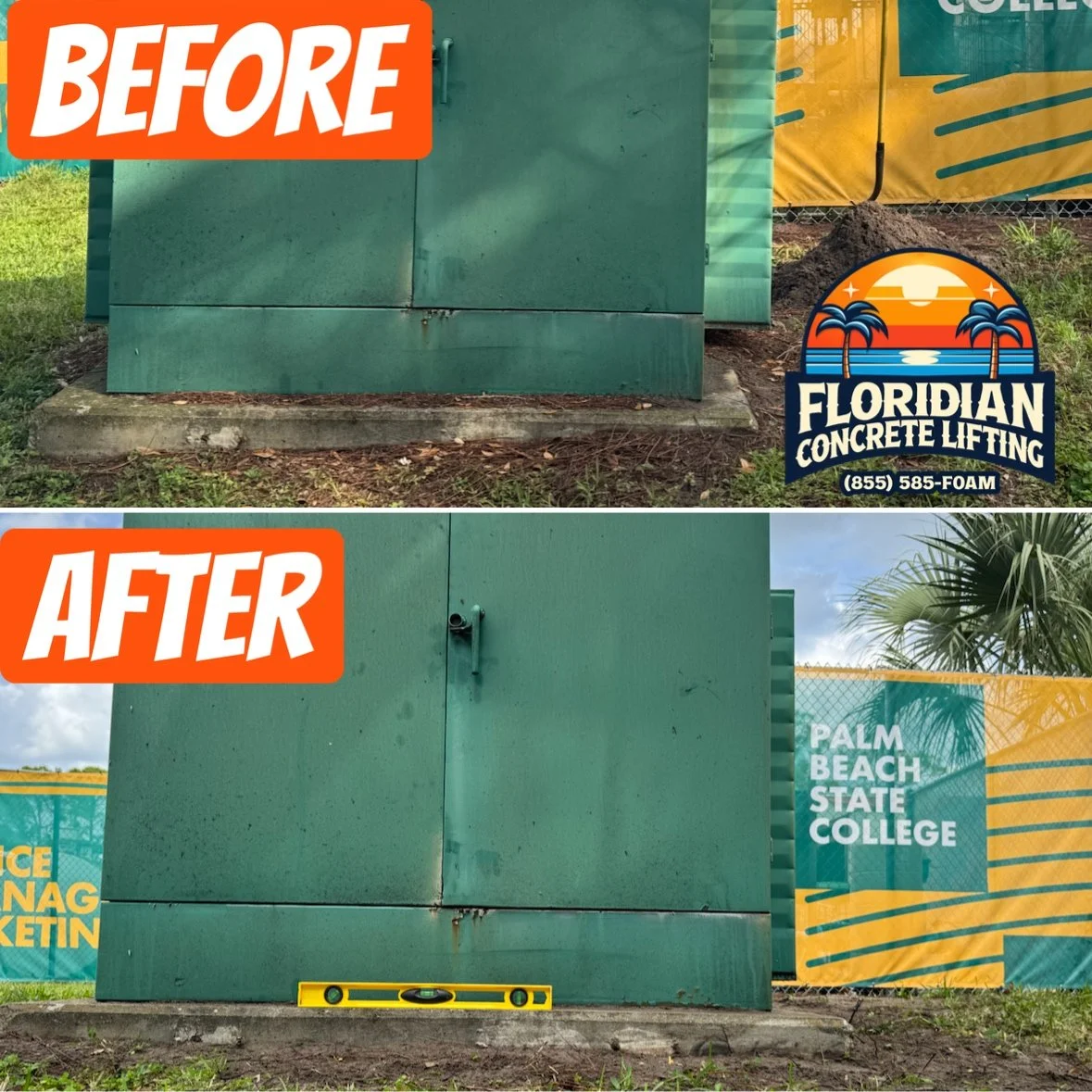
Palm Beach State College — Transformer Pad Lifting & Stabilization. No power shutdown, no replacement — just restored support.
Commercial & Industrial: Warehouses, Plazas, Loading Docks — and Grocers
Concrete movement at joints and dock aprons is common where forklifts and trailers cross transitions all day. Stabilizing these areas reduces impact loads on equipment and improves safety. Retailers have an added challenge: stay open. Our foam lifting maintains access and cures fast, so aisles, entrances, and refrigerated areas can remain operational. Details on commercial slab stabilization.
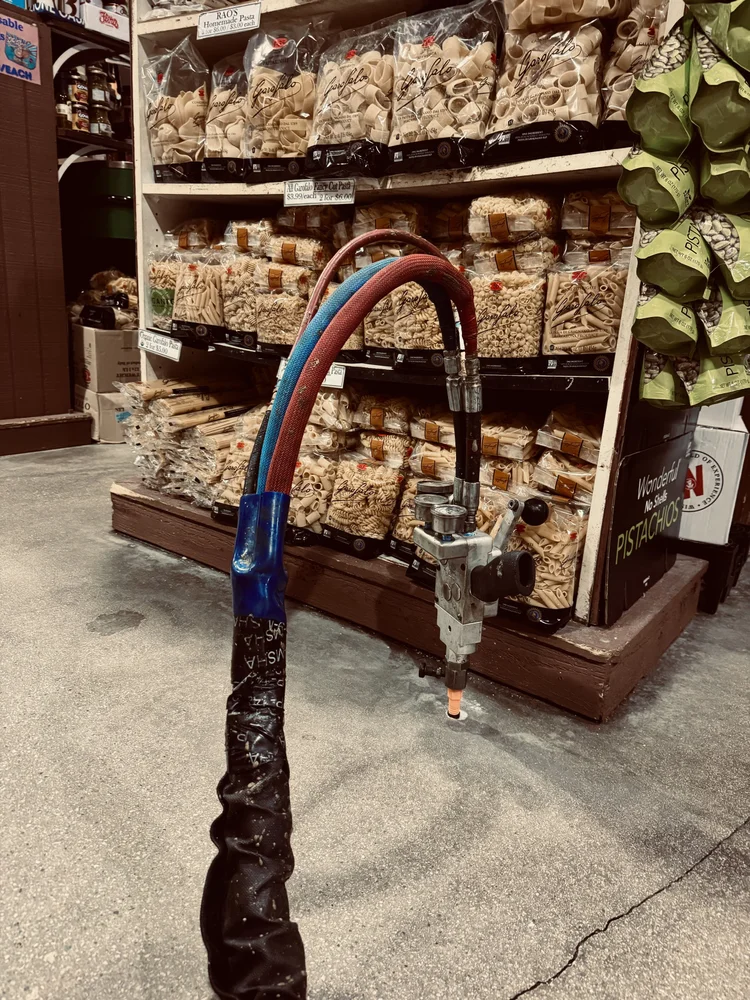
Grocery store slab stabilization completed without shutting down operations — fast, clean, and coordinated with staff.
Golf Courses & Parks
Cart paths and park walkways often settle where water runs off turf or concentrates at edges. Foam lifting extends the life of the hardscape, reduces edge breaks, and keeps routes open for members and guests.
Municipal Walkways & Coastal Hardscape
For cities and coastal properties, controlling water is everything. Our process is popular for sidewalk maintenance programs and for patios near seawalls. Foam helps reduce undermining and erosion behind seawalls, protecting nearby slabs from losing support. Read more about coastal applications on Seawall Erosion Control.
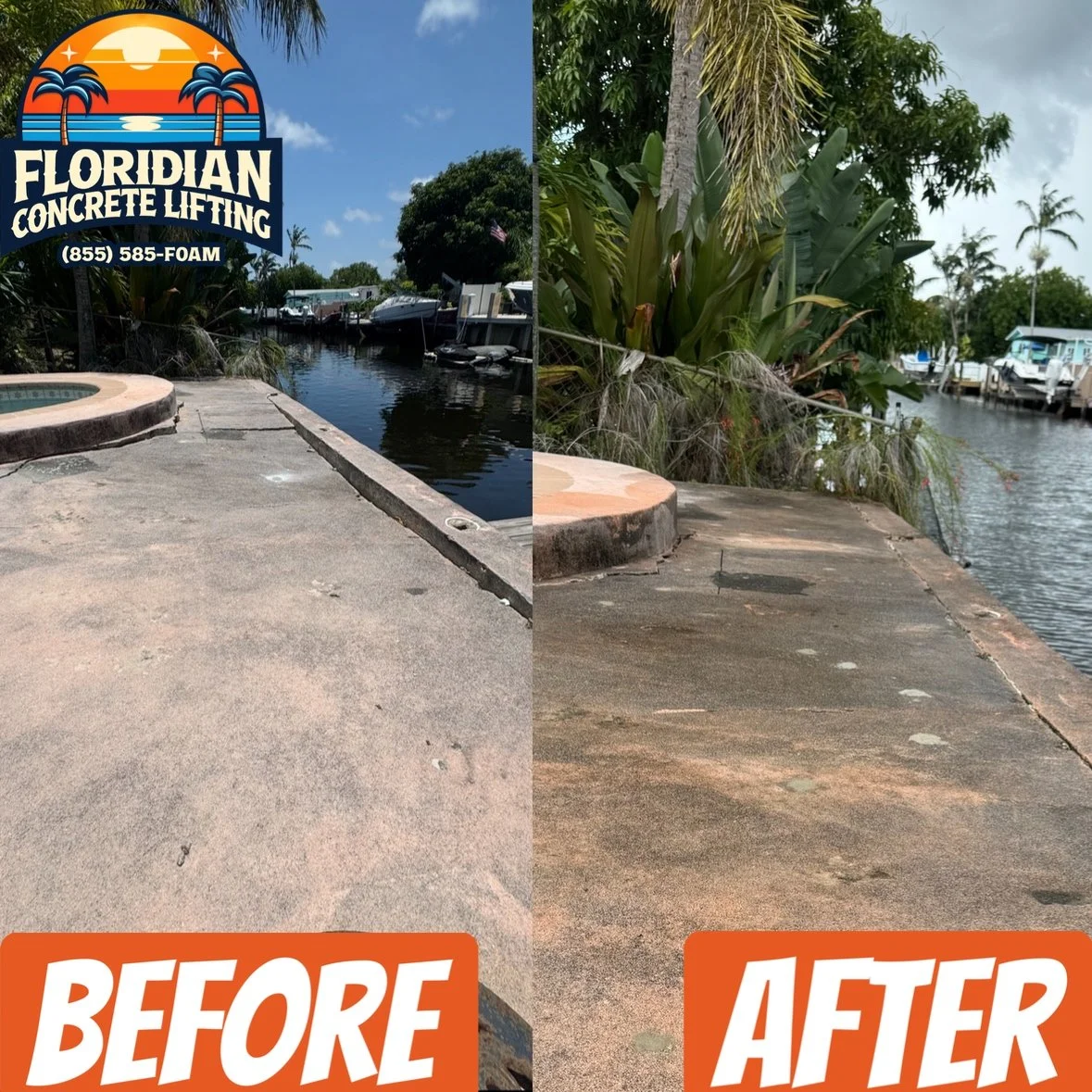
Before & After — Pool deck lift and stabilization completed in a single visit, ready to enjoy the same day.
Safety, Cost, & Downtime: The Case for Foam Lifting
Foam lifting and stabilization is often 40–60% less than replacement, and because there’s no demolition or cure time, the “soft costs” — tenant disruption, lost access, lost sales — are dramatically lower. For HOAs and municipalities, removing trip hazards also reduces liability exposure. For businesses, stabilizing joint voids at docks and aisles protects equipment and operators while keeping operations online.
Preventative Maintenance: Keep Slabs Lifted & Supported
- Extend downspouts: Discharge water 4–6 feet from slab edges; use splash blocks or piping.
- Tune irrigation: Avoid overspray on hardscape and reduce run times during rainy seasons.
- Backfill low edges: Keep soil and landscape beds level with slab edges to discourage washout.
- Listen for “hollow”: If tapping an edge sounds hollow, call before it drops.
- Protect high‑load zones: In warehouses, monitor slab joints and apron transitions seasonally.
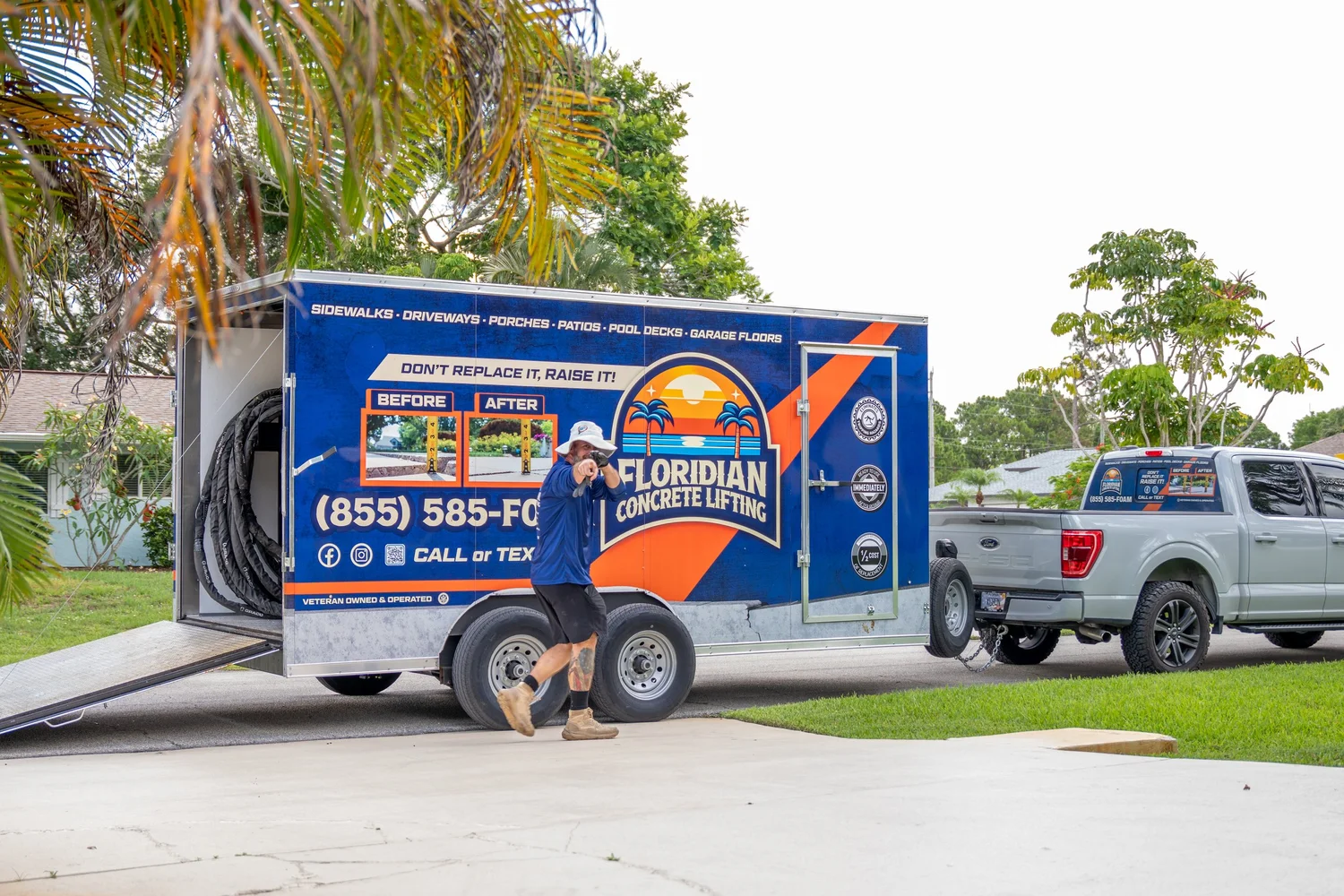
Veteran‑owned and operated — the right crew, equipment, and process for Florida’s soil and water conditions.
Frequently Asked Questions
How long does concrete lifting & stabilization last?
The foam is designed for long‑term performance. It’s waterproof, chemically stable, and resists erosion. Because it also densifies the surrounding soil, the support it creates is durable in Florida’s wet/dry cycles.
Can you work around pools, landscaping, and open businesses?
Yes. Foam is injected through small ports and cures inert. We routinely lift pool decks and garden‑adjacent patios with minimal disturbance, and we coordinate with commercial teams to maintain customer access (see the grocery store example above).
Is this the same as mudjacking?
No. Traditional mudjacking uses a heavy cement slurry and larger holes. Our process uses a lightweight, high‑density foam with smaller ports. Foam won’t add weight that can trigger more settlement in weak soils.
How soon can I use the surface?
Most areas are ready for foot traffic immediately and vehicle traffic the same day. Commercial sites often reopen repaired zones before we leave.
Do you lift interior slabs?
Absolutely. We lift and stabilize interior residential and commercial slabs frequently. The process is clean and controlled; we protect finishes and contain dust. See interior slab stabilization for details.
How do estimates work?
We start with a free site assessment. You’ll receive a straightforward proposal with scope, pricing, and timeline. No gimmicks — just the right fix for the issue. Contact us to schedule.
Ready to Lift & Stabilize Your Concrete?
From Palm Beach to Miami‑Dade, Broward, the Treasure Coast, Orlando, Tampa, and surrounding areas, Floridian Concrete Lifting delivers clean, fast, and long‑lasting slab lifting and stabilization. Whether it’s a pool deck, a transformer pad, an HOA sidewalk route, a golf cart path, or a commercial floor, we’ll restore support with minimal disruption — and help you prevent the problem from coming back.
📞 Call 855‑585‑FOAM or request a free estimate today.

